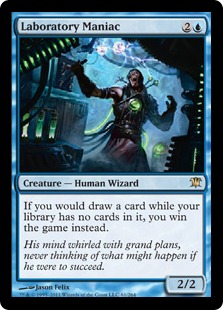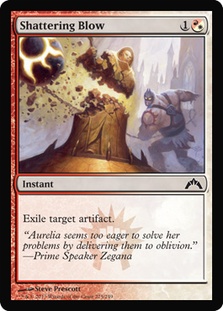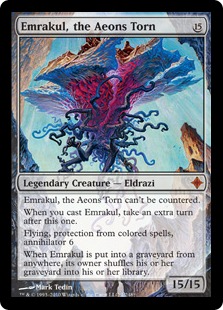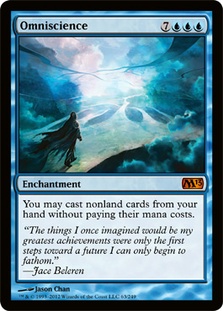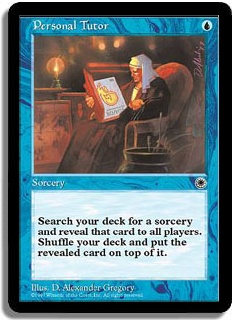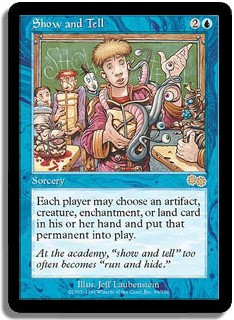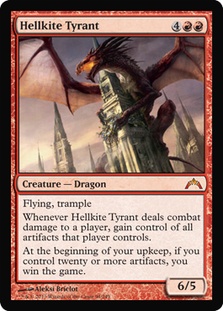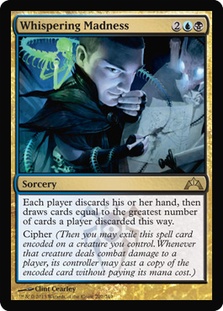Hello all, and welcome back! Last week, I went over the basics of Sealed in anticipation of the Gatecrash Prerelease. In today’s article, I am again going to concentrate on Gatecrash, but this time I’ll focus on how the new set will likely impact another one of my favorite formats, Vintage.
The wonderful weekend that was the Prerelease is behind us, and now emphasis has begun to shift from ooh, how cool! to time to brew Constructed decks.
It’s just like the Byrds sang in their hit 1965 song “Turn! Turn! Turn!”:
“There is a time to learn new cards at the Prerelease and a time to focus on Constructed.“
I’ll preface my discussion by saying it’s a tall order to expect any card to see tournament play in Vintage. Vintage has the largest card pool of any Magic tournament format and allows players to use the most broken cards ever printed. It is telling of the power level when the folks who balance the Commander banned list take the “some of these cards are a little too broken for Commander” stance.
Any new card has to compete against every single other card ever printed to even undergo consideration for a spot in a Vintage player’s 75-card deck.
In order for a new printing to have a shot in Vintage, a card must do at least one of the following things:
I. Provide a novel or unique effect (does something no other card already in existence does). For example, Laboratory Maniac provides an alternate victory condition unlike any other card ever printed.
II. Be similar to an effect that has already proven to be desirable in Vintage but that is in some way (or under some circumstance) better or more efficient than preexisting alternatives. For example, Blightsteel Colossus is an even better Darksteel Colossus.
III. Enable a powerful combination with another preexisting card that is worth building a deck around. For example, when Flash received an errata, it became a two-card “win the game” combination with Protean Hulk worth building one’s entire deck around.
Often, good Vintage playables hybridize multiple elements from these three qualities. For instance, Laboratory Maniac is a unique effect but is also a better Tendrils of Agony (i.e., a win condition for Doomsday decks). If a card is able to meet even one of these criteria, there is a chance it will show up somewhere at some time in Vintage; if it can meet multiple criteria, look out!
Pop quiz:
What is Laboratory Mania?
I. A deck designed by Stephen Menendian.
II. Level 52 in the SNES game Zombies Ate My Neighbors.
III. A typo I just corrected from the previous article.
IV. All of the above.
“I am many things to many people.”
In a discussion of Gatecrash, it is also worth noting multicolored sets are not commonly a hotbed for Vintage staples. The reason is, one-cost hybrid cards aside, that multicolored cards cost a two-mana minimum and are difficult to cast. The vast majority of Vintage staples are artifacts, free spells, or cost a single mana or a single mana plus a colorless.
“For those of you who doubt the power of a single colorless mana, I would be UNPLAYABLE in Vintage if I cost UU instead of 1U.”
The reason is that Vintage games are condensed and making plays and/or forcing interactions during the first and second turns is so critical that most decks can’t afford to play even aggressively costed cards with two-colored mana requirements.
While Gatecrash suffers from being a multicolored set (which means most of the cards in the set will be excluded from Vintage eligibility), the set also suffers from a lack of an obvious Vintage all-star type card. Previous sets have included cards like Snapcaster Mage, Grafdigger’s Cage, Griselbrand, and Rest in Peace that made a very clean transition into Vintage play.
Despite the lack of a true Vintage gem and the handicap of being a multicolor set, Gatecrash does provide us with a few new and interesting options. So without any more hesitation let’s review Gatecrash!
“This card (Shattering) blows my Mind (slaver).”
Perhaps the most difficult part of writing a Gatecrash review will be ignoring the many, many hilarious puns this card title affords me, but my raps (like Will Smith’s) don’t need profanity to get the point across.
I will put my best foot forward and begin with the card I believe to be the most sure thing from Gatecrash for Vintage. Get your foil one—this is a card.
Last year, I wrote about a conversation Paul Mastriano and I had where I complained that my artifact hate spells didn’t deal with the commonly played artifact creature, Blightsteel Colossus. “Why,” I agonized “can’t my maindeckable artifact removal deal with the most important artifact creature in the format?”
I suggested a MTG fan fiction card that I dubbed Clubs to Cookware as a possible solution to the problem.
Clubs to Cookware
W: Instant
Exile target artifact, its controller gains life equal to that artifact’s converted mana cost.
Shattering Blow is very similar to the card I asked for all those months ago. While it is sad that it doesn’t cost a single white mana, I am also well aware that hoping for such an effect for one was asking a lot. In fact, I would have been happy with this effect at instant speed for 1W or 1R, so getting it at a hybrid mana cost of red or white mana is an absolute steal. There was a period of time where I was willing to play with Revoke Existence, and I think this card is much better despite not being able to hit enchantments.
One thing I was never happy about with my more controlling decks was that in order to play an efficient answer to Blightsteel Colossus to Tutor for, I ended up playing with a card that was more often than not a dead draw under normal circumstances. Shattering Blow is a card that will almost always be a respectable draw against the majority of non-Dredge decks (worst-case scenario it is a Stone Rain on a Mox) while at the same time providing a very specific and Tutorable silver bullet effect for a Blightsteel Colossus.
Shattering Blow will be a very good addition to non-white control decks like Grixis that would really like a Tutor target to answer BSC but not at the expense of having to play a narrow spell like Echoing Truth or Hurkyl’s Recall.
I also like the ability to exile an artifact as a permanent answer to a Time Vault. If you Blow it away, your opponent can’t Yawgmoth’s Will, Regrowth, or Goblin Welder it back into play because the Vault will be in exile for the duration of the game. If you Shattering Blow up a Time Vault, the option of infinite turns is taken completely off the table for your opponent; it is always nice when your opponent doesn’t have any options.
“What am I, Napoleon!?”
There are about a thousand cards that can destroy a Time Vault, but there are not really very many cards that can exile it, and of the exile options that do exist, most are not even close to being Vintage playable, which makes Shattering Blow a special card.
Let’s transition from a card that undoes something broken to a card that has one of the most broken effects ever.
“Patrick Chapin once asked me, ‘What is the appropriate casting cost for a spell that wins the game?’ Apparently, the correct answer is 8UUUU.”
Quick question:
“What is up with all the over the top win the game effects that are seeing print?”
“Cards for combo fans that can’t be bothered to learn to play Magic or count.”
I’m not saying that if you play with one of these cards, you don’t know how to count. These are just clearly broken cards that can be cheated into play and essentially win the game on the spot.
My point is that every Magic card is supposedly designed with a target audience in mind and cards like these three are examples of extremely lazy card design aimed at the most unimaginative players. Let’s face it: these are cards that say “win the game (except under a few specific circumstances).” The vast majority of the time that one of these cards resolves, it simply prompts a concession from the opponent, which I would argue is the mark of poorly designed cards.
Perhaps for tournament play R&D decided it takes too long for people to manage mana, count storm, and go off with Tendrils. Thus a one-card “win the game” combo is better for Constructed play because it doesn’t take a long time to execute. I don’t know.
Anyway, while I am generally not a fan of cards like this, it certainly doesn’t mean that I won’t play with them. Under most circumstances in Vintage, resolving an Enter the Infinite will basically be the same as resolving a spell that says “win the game.”
Creatures (1)
Lands (13)
Spells (45)
- 2 Sensei's Divining Top
- 1 Brainstorm
- 4 Show and Tell
- 1 Mystical Tutor
- 4 Force of Will
- 1 Mana Vault
- 2 Hurkyl's Recall
- 1 Ancestral Recall
- 1 Mana Crypt
- 4 Personal Tutor
- 4 Dream Halls
- 1 Black Lotus
- 1 Lotus Petal
- 1 Mox Emerald
- 1 Mox Jet
- 1 Mox Pearl
- 1 Mox Ruby
- 1 Mox Sapphire
- 4 Pact of Negation
- 1 Ponder
- 4 Omniscience
- 4 Enter the Infinite

While I generally dislike the existence of cards that break the longstanding rules of the game, like Omniscience (you have to pay something to cast spells) and Enter the Infinite (win the game shouldn’t be a spell), now that they do exist teaming them up is kind of a no-brainer.
The concept behind this deck is to Show and Tell Omniscience or Dream Halls into play and then win the game with Omniscience. I generally like the idea of this deck being mono-blue to protect against opposing Wastelands and provide consistency for cards to pitch with Dream Halls.
The only way this deck can win is to cast the Enter the Infinite combo with Laboratory Maniac. Enter essentially Tutors for Laboratory Maniac, an arbitrarily large number of counterspells, and the conditions for which Maniac wins the game. Pretty neat.
I got a chance to goldfish the deck and it seemed pretty consistent, but I am sure it could be dramatically improved. A couple of things I would consider moving forward are the inclusion of Tinker + BSC, a way to kill Gaddock Teeg or Meddling Mage (which are both a death sentence for my current build), adding black for better Tutors, and/or incorporating Hive Mind and/or Emrakul as possible alternate victory conditions.
While the deck is a rough draft, a few pieces of technology that may be useful moving forward with such a deck are:
“I hired a Personal Tutor to help me with my Show and Tell assignment.”
I. Personal Tutor to find Show and Tell or Enter the Infinite.
II. Pithing Needle to stop Griselbrand.
III. Boseiju, Who Shelters All to resolve Show and Tell.
Enter the Infinite fits the criteria of a possible Vintage playable card because there has never been a spell like it before! Draw your whole deck is certainly a new effect, and it is also an effect that is worth building around.
While Enter the Infinite might not take the metagame by storm today or tomorrow, the fact that it exists makes it a card that can always get better with the future printing of subsequent support cards.
Shattering Blow and Enter the Infinite are the two cards I think will have the largest Vintage impact from this set. However, there are still a few more cards that I wouldn’t be surprised to see as potential role-players in the future.
“Sick anti-Oath technology?”
Illness in the Ranks could be a sideboard card against Oath of Druids decks. Basically, Illness in the Ranks gives all creature tokens (including your own) -1/-1; all Spirit tokens an opponent gives you with their Forbidden Orchard die to state-based effects for not having toughness. If you don’t have creatures in your deck, putting an Illness in the Ranks into play basically ensures that your opponent can’t give you Spirits with their Forbidden Orchard and thus cannot activate their Oath of Druids.
Shutting down Oaths for a single mana is great, but the applications for this card are narrow. First of all, only black creature-less decks can even consider messing around with Illness in the Ranks since killing all of your Spirit tokens with a Dark Confidant in play accomplishes nothing. Yet, I could see where an Intuition Tendrils style combo deck might very much want to use this card. It is nice that one Illness in play answers every Oath of Druids an opponent plays as long as it is in play, which is what we in the biz refer to as value.
Also, it is worth noting that Illness in the Ranks will infect and decimate an entire Warrens worth of Empty tokens.
All of these things considered, Illness in the Ranks will see Vintage play.
“All of your permanents, give them to my Dragon.”
Hellkite Tyrant is a card that sometimes will be the biggest blowout in the world and most of the time will be strictly worse than other available options. Nonetheless, somebody will Oath of Druids this up against a Workshop player who will be very, very sad.
If you hit them, you take all of their stuff.
“Is a four-mana unrestricted Windfall with upside even playable?”
Windfall is on the Vintage restricted list, which would lead us to believe that in some way, shape, or form it is a powerful Magic card. Whispering Madness costs a B mana more than its restricted counterpart but gets the added bonus of having the cipherability attached to it.
Generally speaking, it is my belief that costing one less B to not have the cipher ability makes for a much better card. However, there is plenty of room for a card to be abstractly worse than Windfall and still see some fringe play in Vintage. Whispering Madness also has the upside of not being restricted.
Just for fun, I built a Whispering Madness deck that I plan on playing with some of my friends next week.
Creatures (10)
Lands (9)
Spells (41)
- 1 Brainstorm
- 1 Vampiric Tutor
- 1 Yawgmoth's Will
- 4 Force of Will
- 1 Mana Vault
- 1 Wheel of Fortune
- 1 Sol Ring
- 1 Demonic Tutor
- 2 Hurkyl's Recall
- 1 Time Walk
- 1 Ancestral Recall
- 1 Mana Crypt
- 1 Windfall
- 1 Time Vault
- 1 Skullclamp
- 1 Memory Jar
- 2 Lightning Greaves
- 1 Tinker
- 1 Crop Rotation
- 1 Voltaic Key
- 1 Black Lotus
- 1 Lotus Petal
- 1 Lion's Eye Diamond
- 1 Mox Emerald
- 1 Mox Jet
- 1 Mox Pearl
- 1 Mox Ruby
- 1 Mox Sapphire
- 2 Chrome Mox
- 1 Ponder
- 2 Mox Opal
- 3 Whispering Madness
Sideboard

As a thought exercise, I wanted a deck that I could cipher my Whispering Madness onto creatures in order to get full value out of my spell. Goblin Welder, Basking Rootwalla, and Cloud of Faeries are all cards that progress my “going off” while also being targets to attach the cipher ability from Whispering Madness onto.
I also put some thought into making these creatures better in my deck by adding Skullclamp to turn their bodies into extra cards.
While Gatecrash doesn’t appear to have a Jace, Snapcaster, or Griselbrand type of card poised to change the game, the set does provide several interesting options for Vintage tournament play moving forward. Both Shattering Blow and Enter the Infinite are cards that I expect to see played in the future, and a few of the other role-player cards are bound to show up in some decks when the timing is right.
At first look, my impression of Gatecrash for Vintage is that Enter the Infinite could be a thing and that there are a few role-player cards that likely won’t shake up the metagame. We have gotten pretty spoiled with premier quality Vintage playables in almost every set for the past couple of years, so it was only a matter of time before one set didn’t give us a brand new tier 1 thing to do.
Enjoy the new cards and ENTER THE INFINITE (if you dare)…
Cheers,
Brian DeMars
 |
I am Selesnya. If forced to live on an all city planet, I would definitely join the “back to nature” group. The thing I love about the Selesnia guild is that on a plane dominated by varying degrees of villainy, the Selesnyans are the one heroic group of the bunch. |

